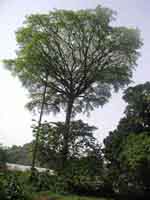Why is this species important?
Moabi is botanically, ecologically and economically important. Baillonella is a monotypic genus with no closely related species. It is a one of the largest trees to be found in the Congo Basin, growing to a height of 60 m and up to 5 m in diameter. Within the Congo biodiversity hotspot moabi is found only in primary and old secondary rainforest. Elephants and other forest mammals eat the fruits of the species. The timber is very important as a source of export earnings. Oil from the seeds is important in the local economy. The bark is used medicinally and the species is culturally important to the Baka pygmies.
Where is it found?
B. toxisperma is found only in rainforests of Central and West Africa. It occurs mainly in Cameroon, Gabon and Nigeria and is also found in Angola, Congo Republic and Equatorial Guinea.
How do people use it?
B. toxisperma is heavily exploited as a commercial timber, particularly in Cameroon and Gabon. In Cameroon, timber from B. toxisperma represents 10% of companies’ total production and between 3.4% and 5% of the total export value of logs of all species. Gabon is the main exporter of B. toxisperma, exporting almost 40,000 m³ in 1998. Demand for the timber is particularly strong in southern Europe. It is used for furniture, cabinet work, decorative flooring, turnery and carving, decorative veneers, joinery and store fittings. For local people B. toxisperma is important in economic, cultural and medicinal terms. The fruits of B. toxisperma are edible and extracts from the bark are used to produce remedies for dental and back problems. Seeds from the fruit are used to make karité oil, which is used for both consumption and trade. In the larger cities in Cameroon, karité oil can be worth as much as US$ 12 per litre. In Cameroonian markets revenues from selling the oil are an important source of income. The value of non-timber products of B. toxisperma has also been recognized by the French cosmetics industry, which has shown an interest in the oil.
Why is it threatened?
The main threat to B. toxisperma is from logging. It is very fragile in terms of its regeneration since it does not flower until it is 50-70 years old and produces fruit only once every three years. In some areas B. toxisperma has already been logged out. In Cameroon B. toxisperma trees within 5km of a village cannot be logged unless the village chief agrees and the population is compensated. In practice, trees have been lost and the population has received no compensation. Logging practices are generally unsustainable and B. toxisperma may disappear from a large part of its original areas of distribution in 10 to 20 years. In the Dja forests of Cameroon, nearly all valuable trees are logged without companies undertaking any initiative to ensure regeneration of the species.
What conservation action is needed?
At present logging companies are not complying with the law and the law itself may provide inadequate protection. In Cameroon, trees less than 1m diameter should not be logged; the figure is 0.8 m in Gabon and Congo Republic. These limits would still leave the regeneration of B. toxisperma at risk. It is argued that the minimum diameter should be increased and measures introduced to conserve ‘mother trees’ that can ensure regeneration takes place. Some argue that there should be a total ban on logging of B. toxisperma.
Moabi is found in several protected areas in Cameroon (Forêt de Nki, Forêt de Boumba Bek and Réserve de Faune de Dja. It is also found in the Sibang Arboretum in Libreville, Gabon. Cameroon has planted 389 ha of B. toxisperma.
Selected references
Forests Monitor (2001) Sold down the river. The need to control transnational forestry corporations: a European case study. Forests Monitor Ltd, Cambridge, UK
IUCN, 1990. La Conservation des Ecosystemes Forestiers du Gabon. IUCN Tropical Forest Programme Series. 200 pp.
Schneemann, J., 1995. Exploitation of Moabi in the Humid Dense Forests of Cameroon. Harmonization and improvement of two conflicting ways of exploitation of the same forest resource. BOS NiEuWSLETTER 31, 14(2), 20-32.
|
 |

|